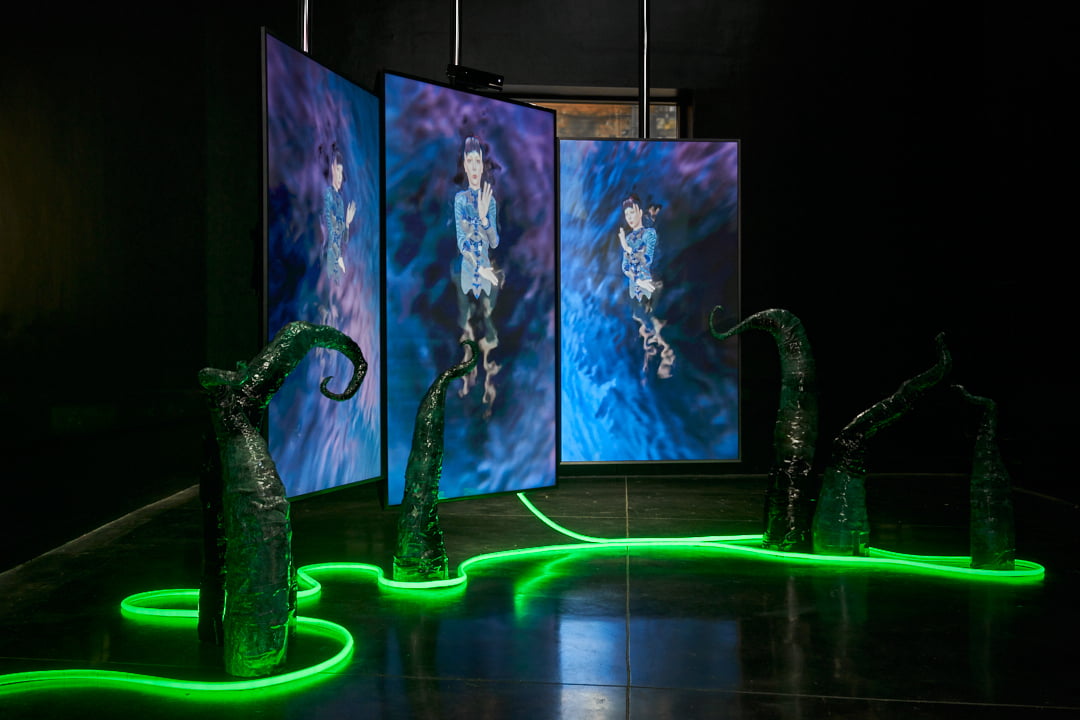
Sian Fan, Deity (2022). Installation view at FACT Liverpool. Image by Rob Battersby.
For the last three years, FACT’s curator-in-residence programme has given UK-based curators the opportunity to develop a major exhibition and programme of events in response to a theme. This year’s curator-in-residence, Carrie Chan, has responded to the theme Radical Ancestry with My Garden, My Sanctuary, an immersive exhibition that explores the complexities of identity and ancestry in a way that is playful but doesn’t shy away from its darker themes.
The impetus for Chan’s response to the theme was her reflection on the complexity of her own identity. Chan grew up in Hong Kong before its authority was returned to China from British control. “For me it was a very interesting topic in a sense that I am originally from Hong Kong. I studied in the UK, but I spent most of my life in Hong Kong, China. I came here in 2020 and that’s when I started to think about my own identity as well. What does it mean to be an immigrant and what does it mean to be Chinese in this country?” For this exhibition, Chan worked with artists Sian Fan and Yaloo.
Sian Fan, an artist of British and Chinese heritage, used east Asian symbols in previous work, but didn’t overtly talk about her mixed heritage. This was something Chan felt she could explore further. “I thought it might be a good opportunity for us to look at why she used symbols such as the lotus or peonies in her work. I thought it might be interesting for her to articulate why they are important to her. She grew up in the UK and she’s never been to China so that’s kind of how it all started.”
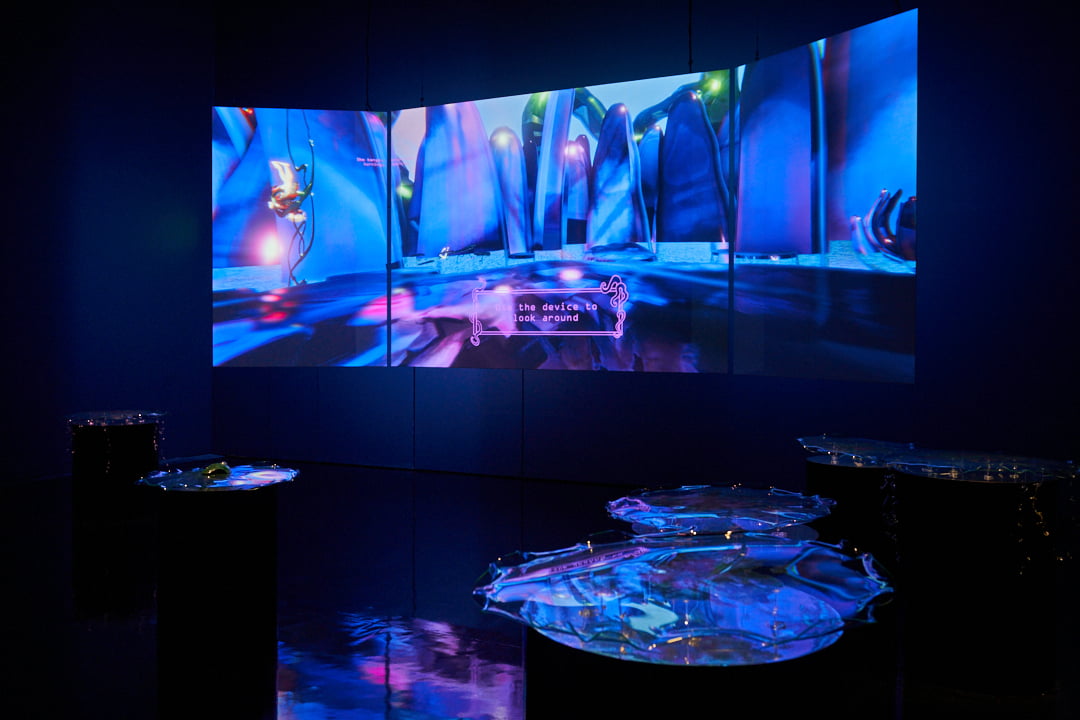
Sian Fan, Lotus Root (2022). Installation view at FACT Liverpool. Image by Rob Battersby.
Interest in Korean culture has exploded in the West – from K-pop to the global success of Netflix’s Squid Game (the most watched series in its history), to the Oscar success of Parasite. South Korean artist, Yaloo, explores how Korean culture is viewed from different perspectives. Chan was interested in how Yaloo used two visual references – the pond and seaweed – to explore this.
The result of Chan’s vision and her curatorial process with the artists is an ambitious, visually rich exploration into identity and representations of Asian culture that have been commodified and exploited.
Sian Fan’s installations are a progression of work she made during her recent residency at the V&A where she explored the concept of duality. “I was looking at the duality between the physical and digital and the false binary that we use to separate the two, but they are entangled and inseparable. [I was] also looking at the duality of my own identity, being half Chinese and half British and using the V&A’s collection as a way to explore that. The show that Carrie ended up curating and envisioning was a much more contemporary experience so it dovetailed nicely into the work I was trying to do at the V&A and everything that was coming out of it, that couldn’t be contained in it, but was really really quite urgent for me.”
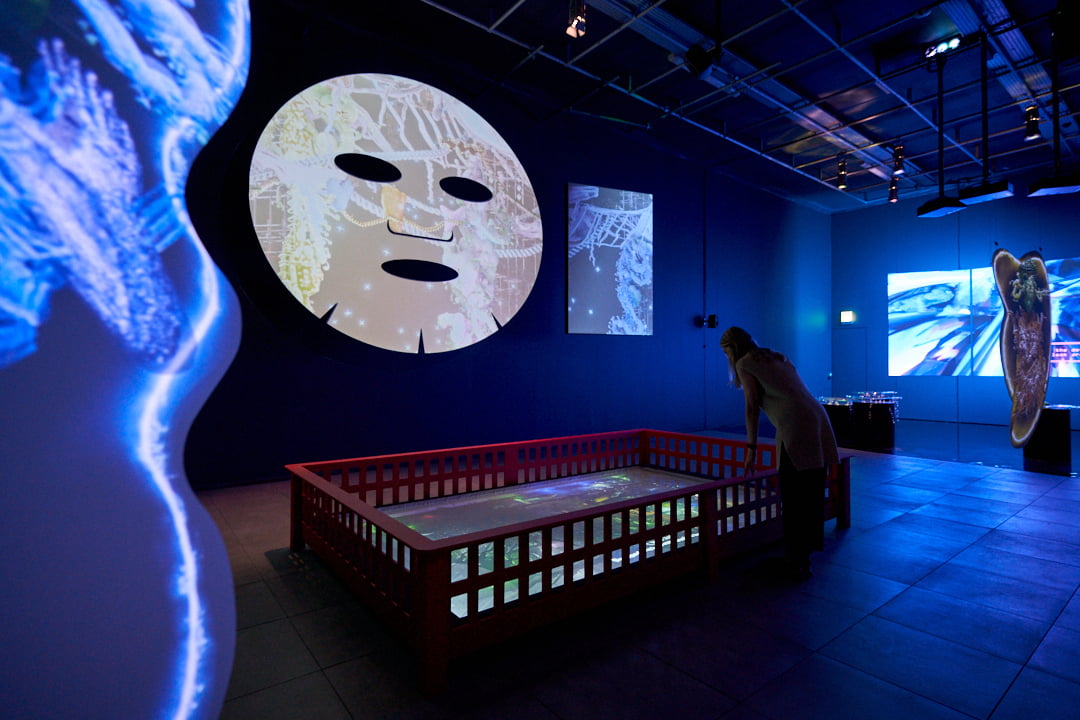
My Garden My Sanctuary (2022). Installation view at FACT. Image Rob Battersby.
One of the symbols Chan honed in on was the lotus. Sian Fan references the lotus root in both works in the exhibition. In Deity, sculptural tentacles emerge from the floor, encircled by a green neon light, that has almost lassoed them, holding them in place as they grasp at a digital triptych suspended from the ceiling where an avatar reflects back the movements of the viewer standing in front of it. In the main gallery, Lotus Root, is a fantasy video game. The digital triptych presents an animated world of floating lotus roots and digitally enhanced avatars of the artist dancing in movements inspired by video games Sailor Moon, Final Fantasy and Grandia. The light on the screen bounces off the inky black floor, hitting the sculptural lotus flowers dotted around the space at waist height. Both installations are dark, creating a feeling of being enveloped in an underwater world that is both playful and shadowy.
In both works, Sian Fan uses the symbol of the lotus to mirror the Asian female body, “[I’ve taken] this hyper-commodified symbol of Asian identity – conjuring up mystical, exotic, oriental images – and am using it as a parallel for how I think I’ve experienced images of Asian femininity. In popular media, the female Asian body is glossy, perfect, pristine. It’s all these things that the lotus flower also represents, this hyper-perfection, but I’m trying to dig beyond that glossy surface into the entangled roots of the murky undergrowth that both supports the beauty on top but also pulls it down into that darker space. There are moments where it fragments, ruptures and moves in a violent way, exposing that underneath this hyper-aestheticisation of these bodies there is a darker, underlying quality in that objectification.”
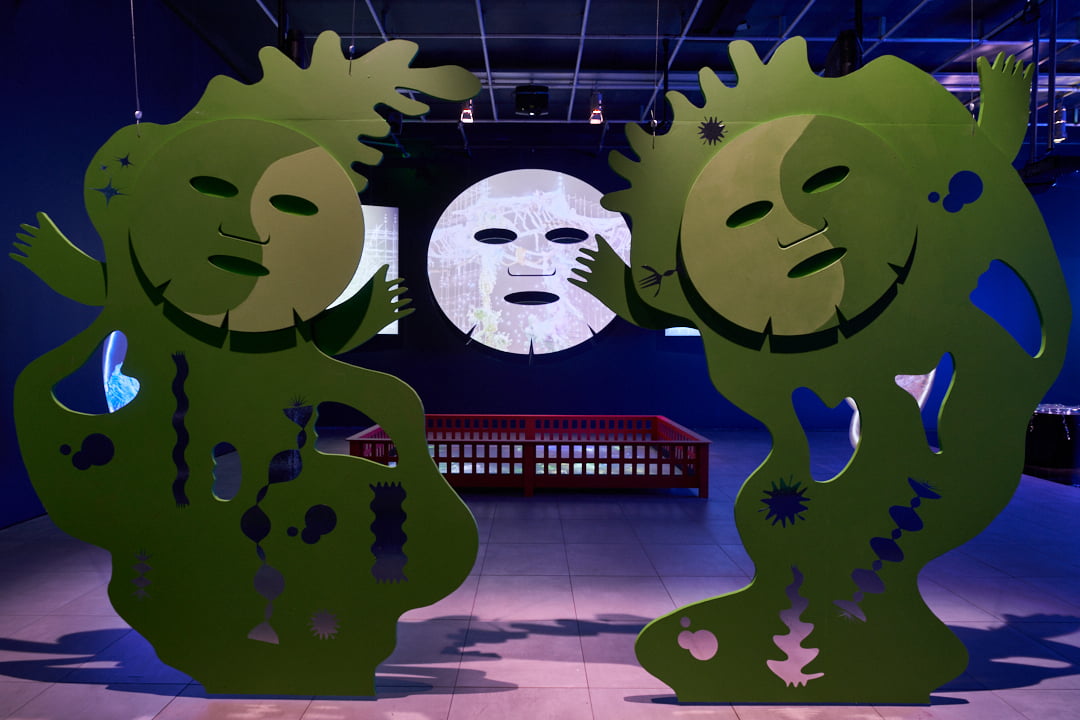
Yaloo, Birthday Garden (2022). Installation view at FACT Liverpool. Image by Rob Battersby.
In her installation, Birthday Garden, Yaloo has created an immersive world that mixes physical sculptural pieces with digital work. Digital avatars dance to K-pop, a watery animated underwater world of seaweed is projected onto the surface of a pond, a large flat, mask-like sculpture hanging from the ceiling watches over everything below. Chan explain’s, “Yaloo’s work is more about the childlike exploration of who you are. Sometimes it doesn’t make sense but you play around with old and new elements.” Yaloo has created a world centred around family – her maternal family – that explores how Korean traditions and rituals have been commodified. Seaweed is used extensively in both traditional rituals and in commercial products, particularly in the beauty industry. Yaloo says, “I feel that seaweed makes a good connection from an old tradition to contemporary culture.”
My Garden, My Sanctuary is an exhibition that benefits from more than one visit. As you spend time with the works, more layers begin to reveal themselves. There are elements of the journey you go through from childhood to adolescence to adulthood, elements of ritual and spirituality. As Chan says, “We don’t necessarily want to place a piece of work and tell other people – this is a message we want people to understand through this playing and interacting.”
***
My Garden, My Sanctuary is showing at FACT until 9 October 2022.
Filed under: Art & Photography
Tagged with: digital, exhibition, FACT Liverpool, Hong Kong, Identity, Korea, Liverpool art, sculpture
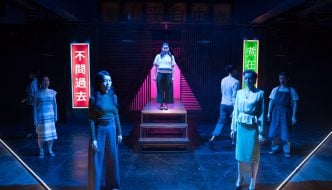

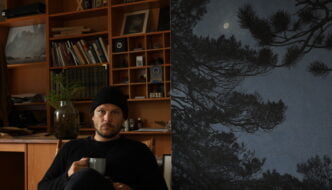
Comments